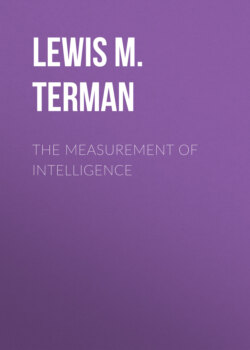Читать книгу The Measurement of Intelligence - Lewis M. Terman - Страница 33
На сайте Литреса книга снята с продажи.
Binet’s conception of general intelligence.
ОглавлениеTable of Contents
In devising tests of intelligence it is, of course, necessary to be guided by some assumption, or assumptions, regarding the nature of intelligence. To adopt any other course is to depend for success upon happy chance.
However, it is impossible to arrive at a final definition of intelligence on the basis of a-priori considerations alone. To demand, as critics of the Binet method have sometimes done, that one who would measure intelligence should first present a complete definition of it, is quite unreasonable. As Stern points out, electrical currents were measured long before their nature was well understood. Similar illustrations could be drawn from the processes involved in chemistry physiology, and other sciences. In the case of intelligence it may be truthfully said that no adequate definition can possibly be framed which is not based primarily on the symptoms empirically brought to light by the test method. The best that can be done in advance of such data is to make tentative assumptions as to the probable nature of intelligence, and then to subject these assumptions to tests which will show their correctness or incorrectness. New hypotheses can then be framed for further trial, and thus gradually we shall be led to a conception of intelligence which will be meaningful and in harmony with all the ascertainable facts.
Such was the method of Binet. Only those unacquainted with Binet’s more than fifteen years of labor preceding the publication of his intelligence scale would think of accusing him of making no effort to analyze the mental processes which his tests bring into play. It is true that many of Binet’s earlier assumptions proved untenable, and in this event he was always ready, with exceptional candor and intellectual plasticity, to acknowledge his error and to plan a new line of attack.
Binet’s conception of intelligence emphasizes three characteristics of the thought process: (1) Its tendency to take and maintain a definite direction; (2) the capacity to make adaptations for the purpose of attaining a desired end; and (3) the power of auto-criticism.[11]
How these three aspects of intelligence enter into the performances with various tests of the scale is set forth from time to time in our directions for giving and interpreting the individual tests.[12] An illustration which may be given here is that of the “patience test,” or uniting the disarranged parts of a divided rectangle. As described by Binet, this operation has the following elements: “(1) to keep in mind the end to be attained, that is to say, the figure to be formed; (2) to try different combinations under the influence of this directing idea, which guides the efforts of the subject even though he may not be conscious of the fact; and (3) to judge the combination which has been made, to compare it with the model, and to decide whether it is the correct one.”
Much the same processes are called for in many other of the Binet tests, particularly those of arranging weights, rearranging dissected sentences, drawing a diamond or square from copy, finding a sentence containing three given words, counting backwards, etc.
However, an examination of the scale will show that the choice of tests was not guided entirely by any single formula as to the nature of intelligence. Binet’s approach was a many-sided one. The scale includes tests of time orientation, of three or four kinds of memory, of apperception, of language comprehension, of knowledge about common objects, of free association, of number mastery, of constructive imagination, and of ability to compare concepts, to see contradictions, to combine fragments into a unitary whole, to comprehend abstract terms, and to meet novel situations.
